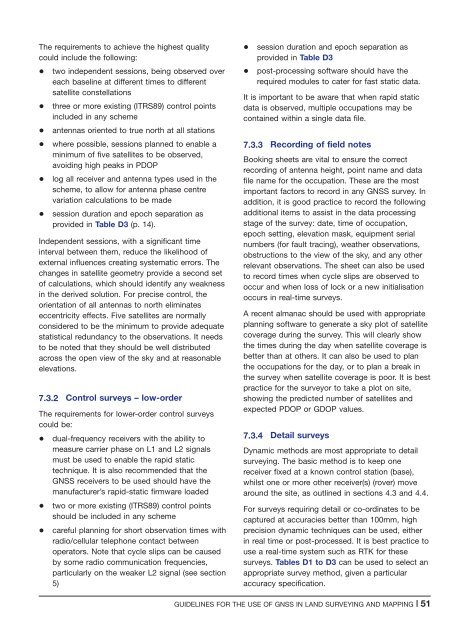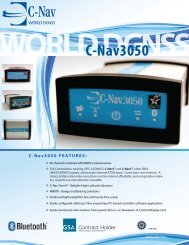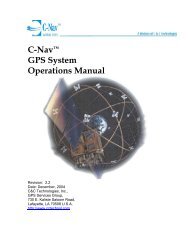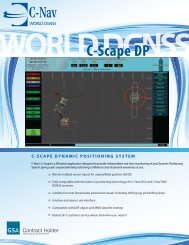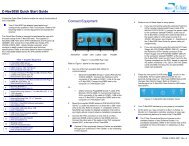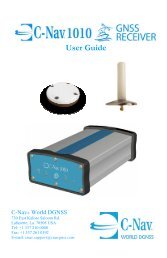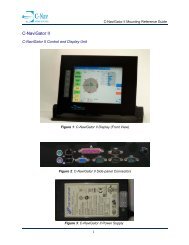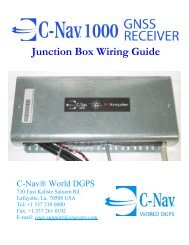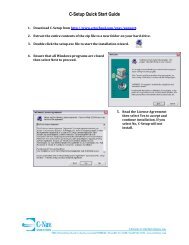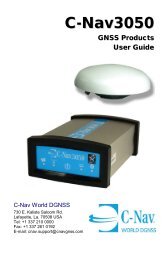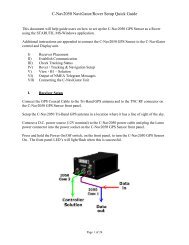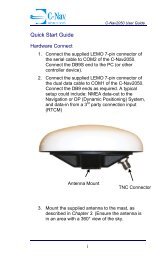Guidelines for the use of GNSS in surveying and mapping
Guidelines for the use of GNSS in surveying and mapping
Guidelines for the use of GNSS in surveying and mapping
Create successful ePaper yourself
Turn your PDF publications into a flip-book with our unique Google optimized e-Paper software.
The requirements to achieve <strong>the</strong> highest quality<br />
could <strong>in</strong>clude <strong>the</strong> follow<strong>in</strong>g:<br />
+ two <strong>in</strong>dependent sessions, be<strong>in</strong>g observed over<br />
each basel<strong>in</strong>e at different times to different<br />
satellite constellations<br />
+ three or more exist<strong>in</strong>g (ITRS89) control po<strong>in</strong>ts<br />
<strong>in</strong>cluded <strong>in</strong> any scheme<br />
+ antennas oriented to true north at all stations<br />
+ where possible, sessions planned to enable a<br />
m<strong>in</strong>imum <strong>of</strong> five satellites to be observed,<br />
avoid<strong>in</strong>g high peaks <strong>in</strong> PDOP<br />
+ log all receiver <strong>and</strong> antenna types <strong>use</strong>d <strong>in</strong> <strong>the</strong><br />
scheme, to allow <strong>for</strong> antenna phase centre<br />
variation calculations to be made<br />
+ session duration <strong>and</strong> epoch separation as<br />
provided <strong>in</strong> Table D3 (p. 14).<br />
Independent sessions, with a significant time<br />
<strong>in</strong>terval between <strong>the</strong>m, reduce <strong>the</strong> likelihood <strong>of</strong><br />
external <strong>in</strong>fluences creat<strong>in</strong>g systematic errors. The<br />
changes <strong>in</strong> satellite geometry provide a second set<br />
<strong>of</strong> calculations, which should identify any weakness<br />
<strong>in</strong> <strong>the</strong> derived solution. For precise control, <strong>the</strong><br />
orientation <strong>of</strong> all antennas to north elim<strong>in</strong>ates<br />
eccentricity effects. Five satellites are normally<br />
considered to be <strong>the</strong> m<strong>in</strong>imum to provide adequate<br />
statistical redundancy to <strong>the</strong> observations. It needs<br />
to be noted that <strong>the</strong>y should be well distributed<br />
across <strong>the</strong> open view <strong>of</strong> <strong>the</strong> sky <strong>and</strong> at reasonable<br />
elevations.<br />
7.3.2 Control surveys – low-order<br />
The requirements <strong>for</strong> lower-order control surveys<br />
could be:<br />
+ dual-frequency receivers with <strong>the</strong> ability to<br />
measure carrier phase on L1 <strong>and</strong> L2 signals<br />
must be <strong>use</strong>d to enable <strong>the</strong> rapid static<br />
technique. It is also recommended that <strong>the</strong><br />
<strong>GNSS</strong> receivers to be <strong>use</strong>d should have <strong>the</strong><br />
manufacturer’s rapid-static firmware loaded<br />
+ two or more exist<strong>in</strong>g (ITRS89) control po<strong>in</strong>ts<br />
should be <strong>in</strong>cluded <strong>in</strong> any scheme<br />
+ careful plann<strong>in</strong>g <strong>for</strong> short observation times with<br />
radio/cellular telephone contact between<br />
operators. Note that cycle slips can be ca<strong>use</strong>d<br />
by some radio communication frequencies,<br />
particularly on <strong>the</strong> weaker L2 signal (see section<br />
5)<br />
+ session duration <strong>and</strong> epoch separation as<br />
provided <strong>in</strong> Table D3<br />
+ post-process<strong>in</strong>g s<strong>of</strong>tware should have <strong>the</strong><br />
required modules to cater <strong>for</strong> fast static data.<br />
It is important to be aware that when rapid static<br />
data is observed, multiple occupations may be<br />
conta<strong>in</strong>ed with<strong>in</strong> a s<strong>in</strong>gle data file.<br />
7.3.3 Record<strong>in</strong>g <strong>of</strong> field notes<br />
Book<strong>in</strong>g sheets are vital to ensure <strong>the</strong> correct<br />
record<strong>in</strong>g <strong>of</strong> antenna height, po<strong>in</strong>t name <strong>and</strong> data<br />
file name <strong>for</strong> <strong>the</strong> occupation. These are <strong>the</strong> most<br />
important factors to record <strong>in</strong> any <strong>GNSS</strong> survey. In<br />
addition, it is good practice to record <strong>the</strong> follow<strong>in</strong>g<br />
additional items to assist <strong>in</strong> <strong>the</strong> data process<strong>in</strong>g<br />
stage <strong>of</strong> <strong>the</strong> survey: date, time <strong>of</strong> occupation,<br />
epoch sett<strong>in</strong>g, elevation mask, equipment serial<br />
numbers (<strong>for</strong> fault trac<strong>in</strong>g), wea<strong>the</strong>r observations,<br />
obstructions to <strong>the</strong> view <strong>of</strong> <strong>the</strong> sky, <strong>and</strong> any o<strong>the</strong>r<br />
relevant observations. The sheet can also be <strong>use</strong>d<br />
to record times when cycle slips are observed to<br />
occur <strong>and</strong> when loss <strong>of</strong> lock or a new <strong>in</strong>itialisation<br />
occurs <strong>in</strong> real-time surveys.<br />
A recent almanac should be <strong>use</strong>d with appropriate<br />
plann<strong>in</strong>g s<strong>of</strong>tware to generate a sky plot <strong>of</strong> satellite<br />
coverage dur<strong>in</strong>g <strong>the</strong> survey. This will clearly show<br />
<strong>the</strong> times dur<strong>in</strong>g <strong>the</strong> day when satellite coverage is<br />
better than at o<strong>the</strong>rs. It can also be <strong>use</strong>d to plan<br />
<strong>the</strong> occupations <strong>for</strong> <strong>the</strong> day, or to plan a break <strong>in</strong><br />
<strong>the</strong> survey when satellite coverage is poor. It is best<br />
practice <strong>for</strong> <strong>the</strong> surveyor to take a plot on site,<br />
show<strong>in</strong>g <strong>the</strong> predicted number <strong>of</strong> satellites <strong>and</strong><br />
expected PDOP or GDOP values.<br />
7.3.4 Detail surveys<br />
Dynamic methods are most appropriate to detail<br />
survey<strong>in</strong>g. The basic method is to keep one<br />
receiver fixed at a known control station (base),<br />
whilst one or more o<strong>the</strong>r receiver(s) (rover) move<br />
around <strong>the</strong> site, as outl<strong>in</strong>ed <strong>in</strong> sections 4.3 <strong>and</strong> 4.4.<br />
For surveys requir<strong>in</strong>g detail or co-ord<strong>in</strong>ates to be<br />
captured at accuracies better than 100mm, high<br />
precision dynamic techniques can be <strong>use</strong>d, ei<strong>the</strong>r<br />
<strong>in</strong> real time or post-processed. It is best practice to<br />
<strong>use</strong> a real-time system such as RTK <strong>for</strong> <strong>the</strong>se<br />
surveys. Tables D1 to D3 can be <strong>use</strong>d to select an<br />
appropriate survey method, given a particular<br />
accuracy specification.<br />
GUIDELINES FOR THE USE OF <strong>GNSS</strong> IN LAND SURVEYING AND MAPPING |51


